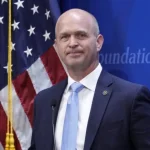

People are still going out and spending money at high levels, a strange dynamic given the country’s inflation and rising interest rates, and it might take the labor market getting whacked for that to change.
Consumer spending is still chugging right along even as interest rates hit multiyear highs and economists warn of a potential recession. The dynamics behind the growth are a bit complicated, and so far, that spending isn’t showing too many signs of letting up. Although, if the country’s job market begins cracking, that could change quickly.
WHITE HOUSE SAYS THE LAW IS MAKING THEM BUILD MORE BORDER WALL
“It’s definitely out of the ordinary,” said Ted Rossman, senior industry analyst at Bankrate, of the dynamic. “Normally when consumer sentiment is depressed as it has been for a few years now and people are worried about a looming recession … normally that sort of darker environment would not lead to quite as much spending.”
While the Biden administration has repeatedly vaunted the economy as historically strong (leaning heavily on the strong labor market and solid gross domestic product growth), most consumers do not agree.
There is a pointed mismatch between consumer spending and consumer sentiment.
While consumer sentiment has improved since the start of the year and was up 16.2% in September from the year before and now registering at 68.1, according to the University of Michigan Consumer Sentiment Index, it is far below where it was before the COVID-19 pandemic took hold in 2020 when sentiment was clocking in at 101. That marks a nearly 33% decline since then.
Low consumer sentiment traditionally means people might be wary about spending more money. But the situation is complicated now because of the country’s inflationary plague. While headline prices are a more modest 3.7% higher today than a year ago, annual inflation rose a monstrous 8% in 2022 and 4.7% in 2021. When consumers compare prices now to what they were just three years ago, it’s difficult to say the economy is in good shape.
“This is one of the best job markets we’ve had in about 50 years — it doesn’t feel good because even though chances are you’re working if you want a job and chances are your wages are up, you feel like those gains are being gobbled up by higher food prices, higher housing prices, higher gas prices, higher prices for just about everything,” Rossman told the Washington Examiner.
Tom Arnold, the University of Richmond Joseph A. Jennings chairman in business and a finance professor, told the Washington Examiner that the dynamic of people spending so much right now is “perplexing” for those who watch the economy.
Rossman said the current situation with higher consumer spending comes down to two main drivers: pent-up demand and pandemic-related factors, plus the country’s strong labor market.
He said that some of it is pandemic-era factors, particularly the surge in experiential spending that is likely still rooted in the pent-up demand from the time of COVID-19.
“A lot of the splurging I see these days is on experiences, not physical goods,” Rossman said. “We’re talking travel, dining, concert tickets, sporting events — I’m surprised how robust all that spending has been.”
Rossman said he thought that last year, the summer of 2022, was going to be the zenith of so-called revenge travel and that people might have gotten the pent-up demand for experiential spending out of their system by now.
But nonetheless, it has remained strong.
There was a notable uptick in travel this year, and blockbuster concert tours — like those of Taylor Swift, Elton John, and Beyonce — proliferated on social media, with fans shelling out sometimes thousands of dollars just to get their way into the jam-packed stadiums. Sporting events are also attracting packed arenas, and restaurants are enjoying good business.
The labor market is the other factor at play, according to Rossman. The unemployment rate recently ticked up to 3.8% but has hovered around 3.5% for over a year, matching the ultralow level it was at before the pandemic took hold. When people have jobs, they don’t shy away from spending as much.
Amid the spending, credit card debt has risen. Credit card debt was at an all-time high of $1.03 trillion in the second quarter of this year, according to the Federal Reserve Bank of New York.
Delinquencies on credit card loans are also on the rise. They hit an all-time low during the pandemic in 2021 as consumers, flush with government stimulus payments, were staying in and spending less, but they have risen fairly dramatically since then.
Still, even though delinquencies have increased, it’s worth noting that they are not historically high. The level of delinquency is now just slightly above where it was before the pandemic. The debt-to-income ratio is also about where it was before the coronavirus came to the fore.
The main thing that will cause consumer spending to reverse course and fall likely comes down to the labor market. While in times past, consumer sentiment and expectations of coming job loss have caused spending to fall, this time around, consumer spending might only meaningfully fall if people start getting laid off and the labor market careens.
“I think that is the biggest predictor of whether or not people can pay their bills and how confident they are in making these bigger purchases,” Rossman said of the job market. And there might be more room for consumer spending to keep going given how strong the labor market is right now, he said.
Arnold said that while he would like to imagine that consumers will be apprehensive and reduce spending before the labor market takes a beating, he isn’t so sure that will actually happen.
“We tend not to react cautiously, we tend to react more in a panic — it’s when the job losses start happening — that’s when the consumer really changes their habits,” Arnold said.
CLICK HERE TO READ MORE FROM THE WASHINGTON EXAMINER
Another factor that might eventually influence the country’s red-hot consumer spending is student loans, Arnold said. The government paused federal student loan payments at the outset of the pandemic. After the date for payments to resume was repeatedly pushed back, borrowers will now have to face more interest and more payments soon.
“Perhaps consumers will start reducing their credit card debt so that they can take care of these other forms of debt and in particular student loans,” he said.




